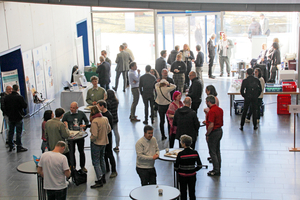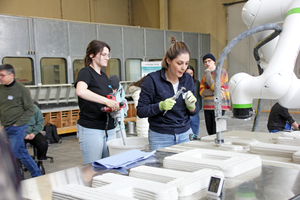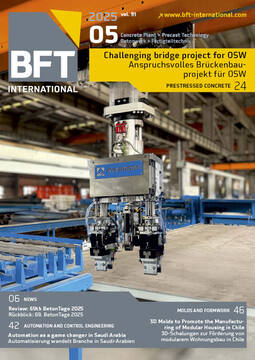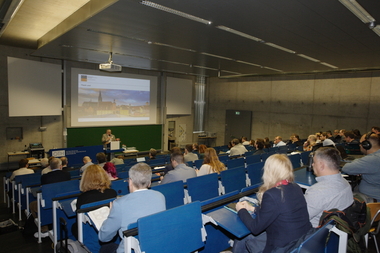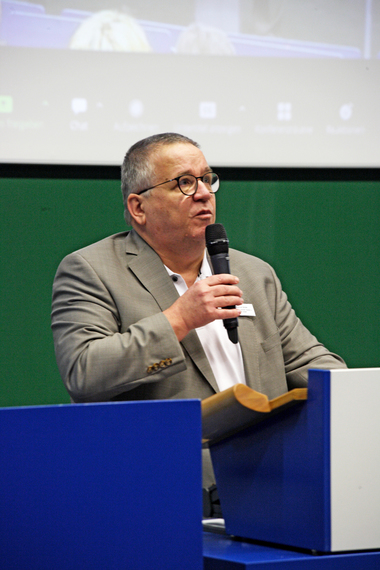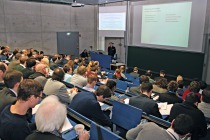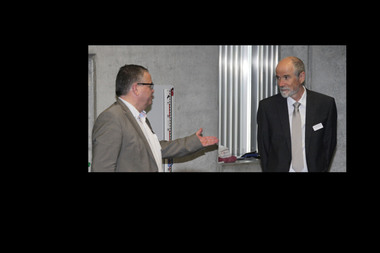34th Conference: „Rheology of Mineral Building Materials“
On February 19, 2025, the conference on the „rheology of mineral building materials“ took place for the 34th time at the East Bavarian University of Applied Sciences (OTH) in Regensburg, with the subsequent workshop on February 20, 2025. The conference was held as a hybrid event, which allowed the about 100 people of 21 countries from all over the world to participate in the exiting lectures personally on site or also online. The conference was opened by the welcoming speech of Prof. Oliver Steffens, the Vice President of the East Bavarian University. Prof. Charlotte Thiel, OTH Regensburg, and Markus Greim, Schleibinger Geräte GmbH, attended the participants through the program.
The first part of the overall ten lectures, among others, was dealing with the beginning of rheology of building materials – flow spread and slump. In his lecture, Callum White of the University of Cambridge, UK, demonstrated current results on computer-aided evaluation of the slump and the rheological parameters deriving thereof. For this purpose, an acceleration sensor was placed on the concrete cone. Michael Autischer of the Technical University of Graz, Austria, also addressed this topic in his presentation. Slump-flow measurements were carried out which were evaluated using methods of image processing, being compared with rheometer measurements.
Olivia Rindle of the Technical University of Munich, Germany, presented the influences of the various mix designs of superplasticizers based on polycarboxylate on cementitious mortars. Here, the critical and saturation dosages of different superplasticizers was determined by measuring the slump flow and investigating their influence on the morphology of formed ettringite.
Numerous international participants and speakers
The rheological measurements on refractory materials were demonstrated by Mahsa Kakavand and Florian Holleyn, University of Applied Sciences Koblenz, Germany. By means of computer-aided analysis of the slump flow, the rheological behavior of free-flowing and non-free-flowing mixtures were examined and discussed.
Rafaela de Kássia Rodriges e Silva, Federal Center for Technological Education of Minas Gerais, Brazil presented investigations on mixtures made of geopolymers with different fillers and activators. Measurements of the flow spread and the rheological examinations were used to characterize the mixtures and their application in the field of 3D printing was discussed.
Calcined clays play an important role in the reduction of clinker in cementitious mixtures. The investigations regarding an impact of various calcined clays and the pore solution on the rheology of these mixtures were presented by Axel Neißer-Deiters, Universität der Bundeswehr, Munich, in his lecture. Supplementary studies on the absorption behavior of superplasticizers and calcium ions were added by measuring the zeta potential.
The measurements of rheological properties of suspensions depend on a lot of factors. A comparison of the measurements on sand/water suspensions performed with two different rheometers was presented by Ana Bruncic, Slovenian National Building and Civil Engineering Institute, Slovenia. She discovered that the measurements carried out with different rheometers are certainly comparable, but the measuring conditions and the measuring parameters such as measuring geometry have to be suitable for the suspension to be measured.
The characterization of accelerated mineral foams is challenging. The method for rheological measurements on mineral foams was developed and presented by Klemens Laub, IAB Weimar, Germany. His method allows an investigation and comparison of mixtures, above all, in respect of their compositions and the workability time at very low shear rates.
The oscillation measurements of fine-grained mixtures using a stellate cell was presented by Vlastimil Bilek of the Brno University of Technology, Czech Republic. With this, he could illustrate the possibilities of oscillation measurements on building materials as well as the difficulties involved in measuring. The series of lectures was concluded with a very interesting presentation, addressing issues outside the universe of building materials. Klaus Neubrand, Schwing GmbH, Germany, provided insights into the topic of pumping sewage sludge and its reuse.
The get-together at the end of the conference day in a pleasant atmosphere in a restaurant in the historic city center of Regensburg has already become a tradition. Hence, this time again, the participants could finish off the day enjoying a meal and drink.
On the second day of the event, the workshop with the practical part on the topic of „3D printing“ took place. The students of Prof. Charlotte Thiel – Merve Karamara and Sophie Albrecht – demonstrated 3D printing of cementitious mortars and clays at two stations.
The next 35th rheology conference in Regensburg will take place in spring of 2026, as usual at the same location, at the East Bavarian University of Applied Sciences in Regensburg.
Schleibinger Geräte
Teubert u. Greim GmbH
Gewerbestraße 4
84428 Buchbach/Germany
+49 8086 94731-10

